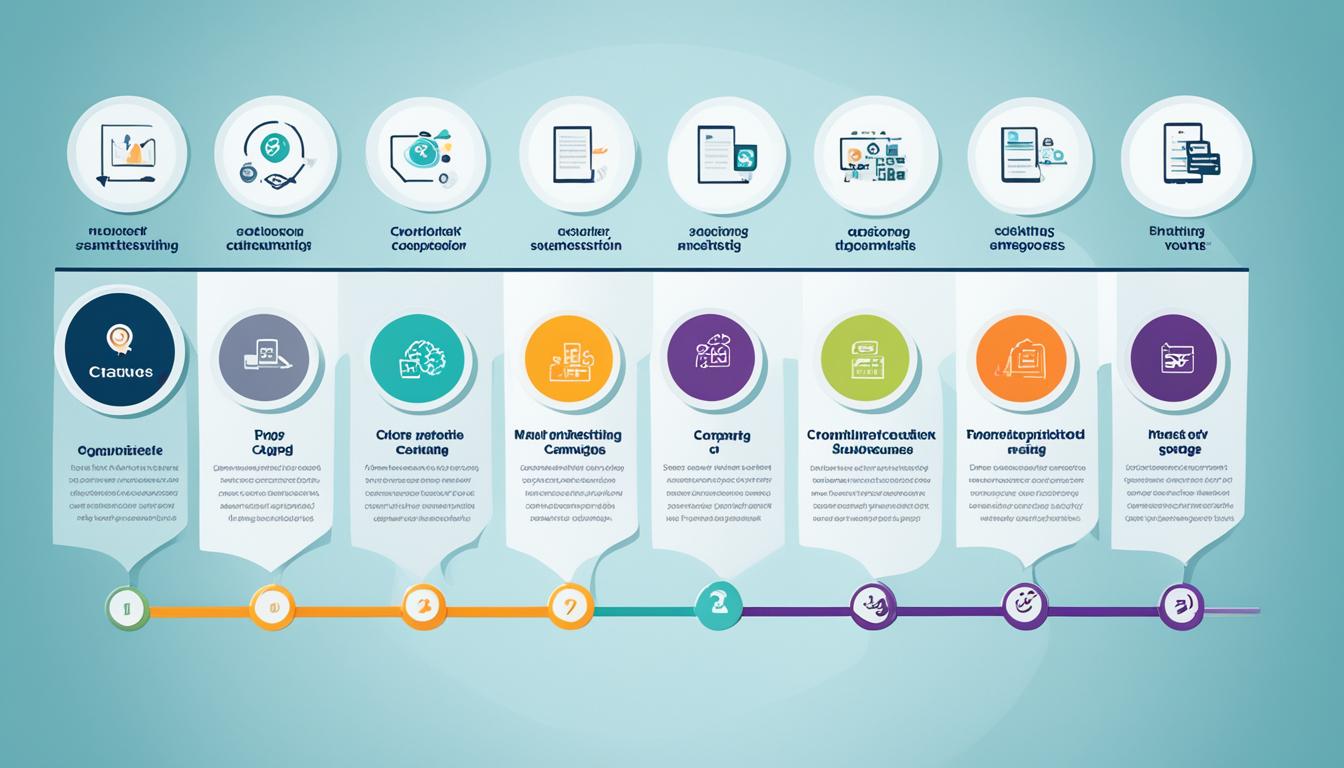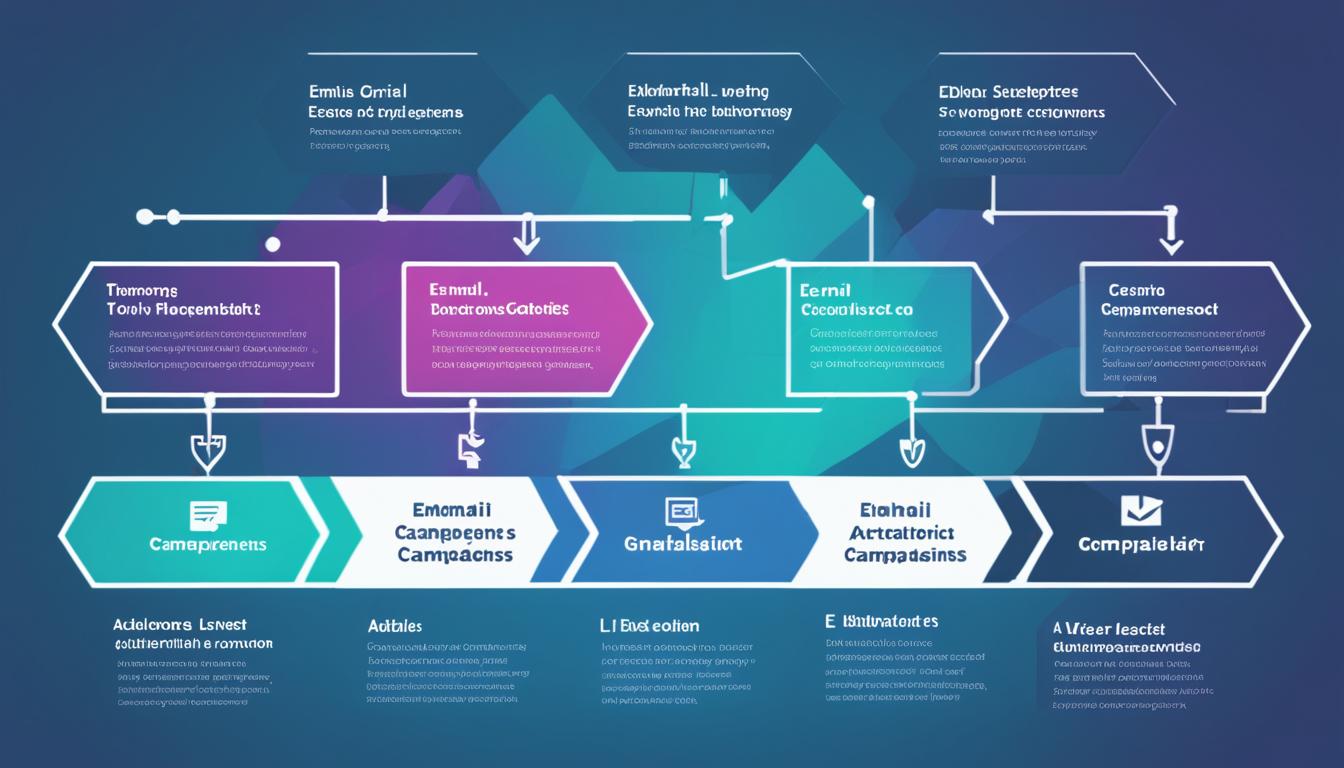Major League Baseball (MLB) is not only America’s favorite pastime but also a powerful force in the world of sports marketing. As the MLB continues to evolve and adapt to the ever-changing landscape, its marketing strategies have become increasingly crucial to engage fans, promote players, and optimize revenue streams. In this case study, we will delve into MLB’s marketing strategy for 2024 and explore the tactics they employ to captivate audiences and solidify their brand positioning.
Key Takeaways:
- MLB’s marketing strategy focuses on promoting players, engaging a diverse audience, and leveraging various channels.
- MLB emphasizes the importance of branding, product marketing, and market share optimization.
- Sports marketing for MLB includes theme-based, product-based, alignment-based, and sports-based strategies.
- MLB’s market position as the leading professional sports league contributes to its success and promotional tactics.
- MLB utilizes product, price, channel, and publicity strategies to achieve its marketing objectives.
The Growing Sports Marketing Environment
Sports marketing has become an increasingly dynamic and competitive landscape, requiring innovative strategies to capture audience attention and drive brand engagement. In this section, we will explore different approaches to sports marketing, including theme-based strategies, product-based strategies, alignment-based strategies, and sports-based strategies.
Theme-Based Strategies
Theme-based strategies involve incorporating a sports theme into marketing campaigns for non-sports products. This approach leverages the emotional connection and passion associated with sports to create a compelling narrative that resonates with consumers. By tapping into the excitement and values of sports, brands can forge a deeper connection with their target audience.
Product-Based Strategies
Product-based strategies focus on marketing sports products without an official relationship with a sports entity. Brands use this approach to highlight the unique features, benefits, and lifestyle associations of their products. By positioning products as essential tools for sports enthusiasts or aligning them with the values of sports, brands can attract consumers who are passionate about the sport.
Alignment-Based Strategies
Alignment-based strategies involve official sponsorships with sports properties. By associating their brand with a specific sport or team, companies can leverage the popularity and reach of sports to enhance brand visibility and credibility. This strategy aligns the brand with the excitement, passion, and values of sports, reinforcing a positive perception among fans and consumers.
Sports-Based Strategies
Sports-based strategies focus on sponsors selling sports products directly related to the sport in question. This approach allows companies to leverage the existing fan base and enthusiasm surrounding a sport to drive product sales. By aligning their offerings with the sport and capitalizing on the passion of fans, brands can create a unique value proposition that resonates with consumers.
As the sports marketing environment continues to evolve, brands must strategically choose from these different approaches based on their target audience, marketing objectives, and brand positioning. Each strategy offers unique opportunities for engaging consumers and driving brand affinity.
| Strategy | Description |
|---|---|
| Theme-based strategies | Incorporating a sports theme into marketing campaigns for non-sports products. |
| Product-based strategies | Marketing sports products without an official relationship with a sports entity. |
| Alignment-based strategies | Official sponsorships with sports properties to enhance brand visibility and credibility. |
| Sports-based strategies | Selling sports products directly related to the sport, leveraging the existing fan base. |
MLB’s Market Position and Promotional Tactics
Major League Baseball (MLB) holds a dominant position as the world’s top professional sports league. With over 70 million attendees at games and a market value exceeding $10 billion, MLB has established itself as a global powerhouse in the sports industry.
To maintain and strengthen its position, MLB employs various promotional tactics to reach its target audience effectively. The league utilizes a combination of traditional and digital advertising channels to maximize its reach and engagement.
MLB’s promotional strategies include:
- TV Commercials: MLB runs captivating and high-production-value commercials on television networks to generate excitement and capture the attention of fans.
- Online Ads: To reach the growing online audience, MLB invests in targeted online advertisements displayed on popular websites, sports platforms, and social media platforms.
- Media Coverage: Securing widespread media coverage through partnerships with leading sports media outlets ensures MLB receives extensive exposure across various channels.
- Merchandising: MLB leverages its strong brand recognition to market a wide range of merchandise, including jerseys, hats, collectibles, and memorabilia. This allows fans to show their support for their favorite teams and players.
As part of its comprehensive marketing strategy, MLB follows the classic marketing mix framework, commonly known as the 4Ps – Product, Price, Place, and Promotion.
| Marketing Mix Elements | Description |
|---|---|
| Product (Players and Teams) | MLB emphasizes the quality of its players and teams, showcasing their skills, accomplishments, and the excitement they bring to the game. |
| Price (Ticket Sales) | MLB strategically prices tickets to attract a wide range of fans, offering various pricing tiers to accommodate different budget levels. |
| Place (Stadiums and Retail Stores) | MLB ensures easy accessibility to its games by strategically locating stadiums in major cities and partnering with retail stores to sell tickets and merchandise. |
| Promotion (Ads and Media Coverage) | MLB invests in extensive promotion through advertisements, media coverage, and partnerships, ensuring maximum visibility and brand exposure. |
By effectively implementing these promotional tactics and utilizing the marketing mix, MLB maintains its market position, attracts diverse audiences, and drives revenue growth.
MLB’s Marketing Strategies
MLB employs various marketing strategies to promote its brand and engage a diverse audience. These strategies can be classified into four main categories: product strategies, price strategies, channel strategies, and publicity strategies.
Product Strategies
Product strategies play a crucial role in enhancing the MLB brand. The league focuses on creating unique branded experiences, such as special theme nights and interactive games, to attract fans. Additionally, MLB merchandise is strategically marketed to generate revenue and strengthen fan loyalty. Through product strategies, MLB ensures that fans feel connected to the league both on and off the field.
Price Strategies
MLB’s price strategies aim to capture a large market share by offering affordable ticket prices. The league understands the importance of accessibility and affordability in attracting fans to games. By implementing pricing strategies that cater to a wide range of budgets, MLB ensures that fans from all walks of life can enjoy the excitement of live baseball.
Channel Strategies
Channel strategies are crucial for reaching a wider audience and maximizing fan engagement. MLB adopts a multi-channel approach, utilizing various platforms such as social media, television networks, and in-person experiences. This allows the league to connect with fans across different demographics and geographical locations, ensuring that the MLB brand remains visible and accessible.
Publicity Strategies
Publicity strategies are integral to MLB’s marketing efforts. The league actively forms partnerships with sponsors and leverages media coverage to increase brand exposure. Additionally, MLB utilizes social media platforms to engage fans, share behind-the-scenes content, and facilitate two-way communication. By effectively executing publicity strategies, MLB establishes a strong presence in the sports industry and builds a loyal fan base.
In summary, MLB’s marketing strategies encompass product, price, channel, and publicity strategies. By focusing on enhancing the MLB brand, providing affordable ticket prices, utilizing multiple channels, and implementing effective publicity tactics, the league successfully engages fans and continues to thrive in the ever-evolving sports marketing landscape.
Engaging Fans Virtually and Leveraging Influencers
As Major League Baseball (MLB) continues to evolve its marketing strategies, it recognizes the importance of engaging fans virtually and leveraging influencers to expand its reach. MLB understands that fan engagement is crucial for building a loyal and passionate fan base, and it has embraced various tactics to achieve this goal.
One of the key ways MLB is engaging fans virtually is through the increased broadcasting of games. By making games accessible to fans, whether through traditional television broadcasts or online streaming services, MLB ensures that fans can experience the excitement of the sport regardless of their location.
Additionally, MLB organizes special events throughout the year to further engage fans. These events can range from fan conventions and player meet-and-greets to community outreach programs and charity events. By creating these unique experiences, MLB strengthens its bond with fans and fosters a sense of community and inclusivity.
Furthermore, MLB has formed partnerships with sponsors to enhance fan engagement. Collaborating with brands allows MLB to create compelling campaigns and promotions that resonate with fans. These partnerships provide opportunities for interactive experiences, giveaways, and exclusive access, all of which further captivate the fan base.
To amplify its presence and reach a wider audience, MLB has also recognized the power of social media influencers. By partnering with influencers who have a strong following and influence within the sports and entertainment realm, MLB can tap into new demographics and expand its fan base. This strategy allows MLB to reach fans who may not traditionally engage with the sport and generate interest among younger audiences, including Gen Z.
One platform that MLB has embraced for engaging younger audiences is TikTok. With its short-form, engaging content, TikTok provides an ideal platform for MLB to showcase its players, highlight exciting game moments, and create viral challenges that capture the attention of Gen Z. By leveraging TikTok’s popularity and trends, MLB can connect with younger fans and introduce them to the excitement of baseball.
Overall, MLB recognizes the importance of engaging fans virtually and staying connected through various channels. By increasing the broadcasting of games, organizing special events, partnering with sponsors, and leveraging social media influencers, MLB ensures that fans remain engaged and excited about the sport. Through platforms like TikTok and other social media channels, MLB aims to capture the attention of Gen Z and younger audiences, connecting them with the rich tradition and excitement of Major League Baseball.
Diversifying Content and Enhancing the Fan Experience
MLB is constantly striving to enhance the fan experience by diversifying its content strategy. By providing a more immersive experience for fans, MLB aims to create a stronger connection between the players and the audience.
One way MLB achieves this is by showcasing behind-the-scenes moments, offering an exclusive glimpse into the players’ lives both on and off the field. These behind-the-scenes moments allow fans to feel more connected to their favorite players, fostering a sense of authenticity and relatability.
In addition to behind-the-scenes content, MLB also incorporates real-time fan reactions into its content strategy. By highlighting the passion and excitement of fans during games, MLB creates a sense of community and unity among fans. This real-time aspect adds another layer of engagement to the fan experience.
Another important element of MLB’s content strategy is storytelling. By sharing compelling human interest stories about MLB players, the league creates an emotional connection with fans. These stories showcase the personal journeys, struggles, and triumphs of the players, allowing fans to connect on a deeper level.
MLB realizes the importance of reaching fans on every social platform. Whether it’s through Instagram, Twitter, Facebook, or YouTube, MLB strives to create content that resonates with fans across all channels. By doing so, MLB ensures that fans can engage with their favorite teams and players no matter where they are.
By diversifying its content strategy, MLB is able to offer a more comprehensive and engaging fan experience. From behind-the-scenes moments to real-time fan reactions and compelling storytelling, MLB is dedicated to creating content that captures the hearts and minds of baseball fans around the world.
The Impact of COVID-19 on MLB’s Marketing Strategy
The COVID-19 pandemic has had a profound impact on MLB’s marketing strategy, affecting various revenue streams and requiring significant adjustments to their content strategy. Key areas that have been heavily impacted include ticket sales, broadcasting, merchandise, and sponsorships. In order to adapt to these challenges, MLB has implemented several changes to engage fans virtually and explore alternative revenue streams.
One of the strategic shifts MLB has made is partnering with influencers to expand their reach and connect with fans in new ways. By collaborating with social media influencers, MLB is able to tap into their established audiences and generate increased engagement with Gen Z and younger demographics.
Furthermore, MLB has recognized the significance of social media platforms such as TikTok as effective channels to capture the attention of their target audience. With the majority of Gen Z active on TikTok, MLB has adjusted its content strategy to create captivating and shareable content that resonates with this demographic.
MLB’s content strategy adjustments have also included a greater emphasis on creating relevant and timely content that aligns with the current global situation. By addressing the challenges and opportunities presented by COVID-19, MLB can maintain relevancy and engage fans through meaningful storytelling and real-time reactions.
These strategic adaptations serve to not only mitigate the negative effects of the pandemic on MLB’s revenue streams but also position the league for long-term success by diversifying their marketing approach and solidifying their connection with fans, even in the face of unprecedented circumstances.
Future Opportunities and Challenges for MLB’s Marketing Strategy
As MLB (Major League Baseball) continues to evolve its marketing strategy, there are both exciting opportunities and unique challenges that lie ahead. To effectively engage with the younger generations, including Gen Z, MLB must explore innovative marketing approaches, form influential partnerships, and create immersive content experiences. However, one of the key challenges MLB faces is integrating these strategies seamlessly with traditional broadcasts while maintaining a cohesive brand identity.
Opportunities for MLB
MLB has the opportunity to tap into the immense potential of Gen Z and younger audiences by implementing forward-thinking marketing strategies. By embracing new technologies and platforms, such as virtual reality (VR) and augmented reality (AR), MLB can provide interactive and engaging experiences that resonate with the younger fan base.
In addition, influencer partnerships can play a crucial role in expanding MLB’s reach and appeal. Collaborating with popular social media influencers who have a strong connection with Gen Z can help MLB build credibility and foster genuine connections with younger fans.
Furthermore, MLB can leverage the power of immersive content to captivate the younger audience. This can include behind-the-scenes footage, player interviews, and exclusive access to events, creating a sense of exclusivity and excitement among fans.
Integration with Traditional Broadcasts
While exploring new marketing strategies, MLB must also find effective ways to integrate these approaches with traditional broadcasts. This integration is essential to ensure a consistent brand experience and maintain the loyalty of existing fans who prefer traditional viewing methods.
MLB can achieve this by seamlessly incorporating interactive elements, such as real-time polls, social media feeds, and fan interactions, into their traditional broadcasts. By doing so, they can enhance the viewing experience for fans while keeping them engaged and connected.
Additionally, MLB can explore opportunities for cross-promotion between traditional broadcasting channels and digital platforms. By strategically aligning promotional activities, MLB can optimize its reach and maximize fan engagement across multiple channels.
Maintaining Cohesive Brand Identity
While embracing innovative marketing strategies and integrating them with traditional broadcasts, it is vital for MLB to maintain a cohesive brand identity. Consistency in messaging, design, and brand values is key to building a strong and recognizable brand that resonates with fans.
MLB can achieve this by aligning their marketing efforts with their overall brand strategy. By clearly defining their target audience, brand positioning, and core values, MLB can ensure that all marketing initiatives are in line with their brand identity.
Moreover, consistent storytelling and content creation that reflects the essence of MLB can help reinforce the brand identity and create a memorable and authentic fan experience.
Evaluating the Success of MLB’s 2024 Marketing Strategy
To determine the success of MLB’s 2024 marketing strategy, it is crucial to analyze various key metrics. These metrics include fan engagement, revenue generation, and social media reach. By evaluating these parameters, we can effectively measure the effectiveness of MLB’s marketing initiatives.
Fan Engagement
Fan engagement is a vital measure of the success of MLB’s marketing strategy. It encompasses the level of interaction, participation, and enthusiasm displayed by fans. This can be evaluated through metrics such as attendance at games, active participation in online discussions, and feedback from fan surveys.
Revenue Generation
Another essential aspect of evaluating MLB’s marketing strategy is the revenue it generates. This includes revenue streams from ticket sales, merchandise purchases, and sponsorships. By analyzing the growth and stability of these revenue streams, we can gauge the effectiveness and profitability of the marketing efforts.
Social Media Reach
In today’s digital age, social media plays a significant role in marketing success. Evaluating MLB’s social media reach allows us to assess the level of brand exposure and engagement with fans on platforms such as Facebook, Twitter, Instagram, and TikTok. By analyzing metrics like follower count, post engagement, and content reach, we can determine the impact of MLB’s social media marketing efforts.
By leveraging MLB marketing success metrics such as fan engagement, revenue generation, and social media reach, we can gain valuable insights into the effectiveness of the 2024 marketing strategy. These metrics provide a comprehensive analysis of the impact and reach of MLB’s marketing initiatives, enabling valuable decision-making and future strategy development.
Lessons Learned and Insights for the Future
MLB’s marketing strategy for 2024 provides valuable insights and lessons for future marketing strategies. It is essential for MLB to continuously adapt and evolve its marketing approach to stay competitive in the ever-changing sports industry. Here are some key takeaways and considerations for MLB’s future marketing endeavors:
Diversifying Content to Engage a Wide Range of Audience
One of the crucial lessons from MLB’s 2024 marketing strategy is the importance of diversifying content to cater to a wide range of audience preferences. By developing various types of content, such as behind-the-scenes moments, human interest stories, and real-time fan reactions, MLB can create a more immersive and engaging fan experience. This strategy enables MLB to reach different demographics and resonate with fans on multiple social media platforms.
Leveraging Influencers for Increased Reach and Engagement
Incorporating influencer marketing into MLB’s future strategies can greatly enhance reach and engagement with younger audiences. Collaborating with popular social media influencers who have a strong presence in the sports and entertainment sphere enables MLB to tap into their existing fan base and extend its brand reach. Influencers can actively promote MLB content, events, and products to their followers, amplifying the league’s visibility and generating more interest among target audiences.
Adapting to Changing Consumer Preferences
MLB’s marketing future success is heavily reliant on its ability to adapt to changing consumer preferences. By staying attuned to the latest trends in technology, social media, and entertainment, MLB can understand the evolving needs and expectations of its target audience. This knowledge empowers MLB to tailor its marketing strategies to meet these changing preferences, whether it’s delivering shorter-form content for platforms like TikTok or leveraging emerging technologies to create immersive fan experiences.
Creating a Cohesive Brand Identity Across Platforms
To maintain a strong and recognizable brand, MLB must ensure a cohesive brand identity across all platforms. Consistency in messaging, visual elements, and brand values helps create a unified brand experience for fans. Whether it’s through logos, color schemes, or storytelling techniques, MLB should strive for brand coherence across websites, social media accounts, merchandise, and other touchpoints. This cohesion reinforces brand recognition and fosters a sense of loyalty among fans.
| Key Insights | Strategies for MLB’s Future |
|---|---|
| Diversify content to cater to different audience preferences | – Produce behind-the-scenes moments, real-time fan reactions, and human interest stories – Create content that resonates across various social media platforms |
| Leverage influencer marketing to extend brand reach | – Collaborate with popular social media influencers with a sports and entertainment focus – Utilize influencers to actively promote MLB content, events, and products |
| Stay adaptable to changing consumer preferences | – Stay updated on trends in technology, social media, and entertainment – Tailor marketing strategies to meet evolving audience needs |
| Maintain a cohesive brand identity across platforms | – Ensure consistency in messaging, visual elements, and brand values – Foster brand recognition and loyalty through unified branding |
These insights and strategies can guide MLB in shaping its marketing approach for the future. By applying these lessons and adapting to the ever-evolving landscape, MLB can strengthen its market position, engage a diverse audience, and drive continued success in the sports marketing realm.
Conclusion
In summary, MLB’s marketing strategy for 2024 has been designed to engage a diverse audience, leverage the power of social media influencers, and optimize revenue streams. By embracing innovative solutions and staying agile in the face of challenges, such as the COVID-19 pandemic, MLB is positioning itself for continued success in the ever-evolving sports marketing landscape.
MLB recognizes the importance of reaching fans through various channels and creating compelling experiences both on and off the field. By actively adapting to the changing preferences of consumers, MLB aims to provide a fan-centric approach that resonates with audiences of all ages, including the influential Gen Z demographic.
With a focus on enhancing fan engagement through immersive content, strategic partnerships, and an increased presence on social media platforms, MLB is effectively strengthening its brand and building a loyal fan base. By consistently evolving its marketing tactics and strategies, MLB remains at the forefront of the sports industry, driving innovation and setting new standards for sports marketing excellence.






